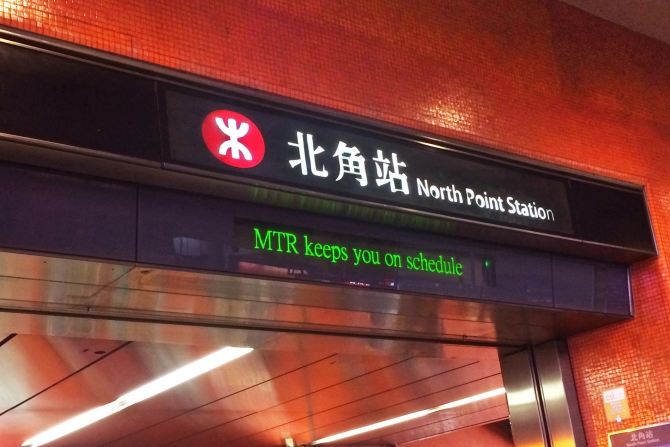
The Old North Point
With many of Hong Kong’s street and district names translated from their English originals in the colonial era, North Point was no exception. “North Point, and its directly translated Chinese name, is so called because it is the northernmost tip along the coast of Hong Kong Island. Interestingly, what we now know as Causeway Bay was once called ‘East Point’ as it was to the east of Victoria City, amongst the first urban settlement after Hong Kong became a British colony, and Western District was once called ‘West Point’,” said Mr. Ko Tim-keung, member of the Antiquities Advisory Board.
While it spans three MTR stations from Fortress Hill to Quarry Bay today, North Point was just a narrow road before the First World War, with fishing, commercial and residential activities being a rarity, according to Ko. “Because of the scarcity of flat land and its location near the mountain and far from the sea, there were only a few quarry mines in North Point very early in history. By the 20th century, several reclamation projects have formed the Chun Yeung Street today; Electric Road and Wharf Road were later formed with the government’s construction of a power station and storage centre in the area; and Oil Street was where the Royal Hong Kong Yacht Club was located – such is how North Point was developed,” said Ko. “Tsat Tsz Mui Road, before the First World War, was a beach frequented by swimmers and Dragon Boat enthusiasts, and it also happened to be where the Ming Yuen Playground, famous in 1918, was built.”
Behind every nook and cranny of North Point is a historic tale, such as King’s Road Playground, which used to be a refugee camp during the First World War, was later turned by the Japanese into a prisoner-of-war camp during the Japanese occupation of Hong Kong. “What may still hit locally born and raised senior citizens as fresh memory, is the renovation of the camp site into one of the offices for Hong Kong identity card registration and issuance after the war.”
Post-war Prosperity
Transformed by a series of reclamation projects, North Point, when juxtaposed with old photos, inevitably brings back poignant memories. “If you knew that the old coastline was where the tramway is today, you would have an idea how much of the land in North Point was formed by reclamation,” said Ko. Had it not been for the Canton-Hong Kong strike, the construction of the sugar factory on the newly reclaimed land, proposed by the Hokkien-Indonesian ‘Sugar King’ Kwok Chun-yeung in 1921, would not be scrapped and replaced with a happening residential development. “Post-Second World War North Point was endearingly called ‘Little Fujian’ as the majority of settlers were originally from the south of Fujian. By the 1960s, the influx of immigrants from Shanghai also brought with them the ballroom culture to North Point, hence the likes of the famous Ritz Garden Nightclub began to spring up like mushrooms. Nightclubs in that era were usually colossal, with a magnificent flair to match. Ritz Garden, for instance, featured antique-style pagodas and ponds, and was where the first unofficial Miss Hong Kong, Ms Lee Lan, was crowned. With overseas Chinese millionaires pouring in support for the glamorous nightclub industry, North Point soon became ‘Little Shanghai’, buzzing with brisk business.”
“Glamor aside, North Point also witnessed the construction of the North Point Estate by the Hong Kong Housing Authority. Despite being a public housing estate, North Point Estate was reputed as Asia’s first revolutionary housing scheme for its design and planning, complete with the incorporation of balcony, independent kitchen and bathroom spaces, lifts, community hall, bus terminal, post office, and ferry pier; with a minimum income floor required of its tenants, the North Point Estate was arguably an exemplary case of ‘luxurious’ housing back then.”
The Stories Behind Street Names
Unlike Central, Sheung Wan or Shau Kei Wan, whose development came as a result of maritime trade, North Point’s rapid development took off only after the Second World War, and with its relatively shorter history, historical relics are scarce, accordingly to Ko. But still, it is worth looking at the stories behind the street names in the area: The Chinese translation of ‘Power Street’, for instance, was the consequence of the misunderstood meaning of ‘power’ as in ‘power struggle’ instead of ‘power supply’; Chun Yeung Street, Tong Shui Road, and Java Road, incidentally, were named as a tribute to the sugar trader Kwok Chun-yeung; while ‘Wo Fu Road’ is the direct phonetic translation from ‘Wharf Road’.
What it lacks in history, North Point makes up with the interesting stories from its streets and alleys. For a walk down memory lane from North Point to the entire Island East, Ko recommends hopping on the tram for a ride: “By all means stop by Braemar Hill and Choi Sai Woo Park if you’re into hiking.” Of course, if you prefer to read about stories of North Point and Island East, there are a few books on the historical transformation of these parts of Hong Kong too, such as the book on the streets of Hong Kong’s Central District by Xia Li.
Go on, explore the historic tales of these streets you probably walk or commute on every day. Who knows, you may now look at them different, knowing the stories behind!
Special Thanks:
Mr Ko Tim-keung, member of the Antiquities Advisory Board